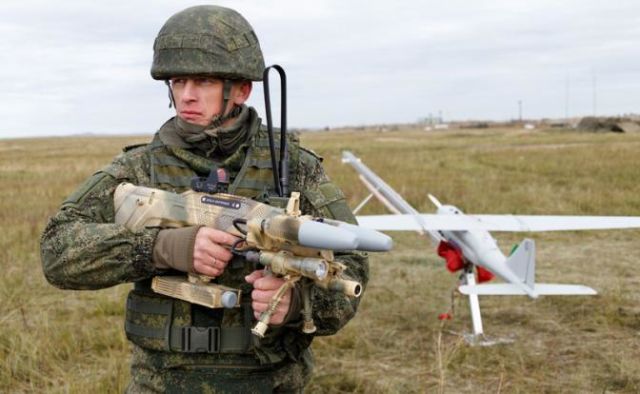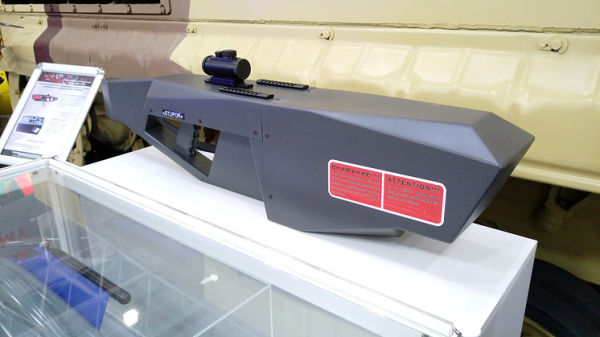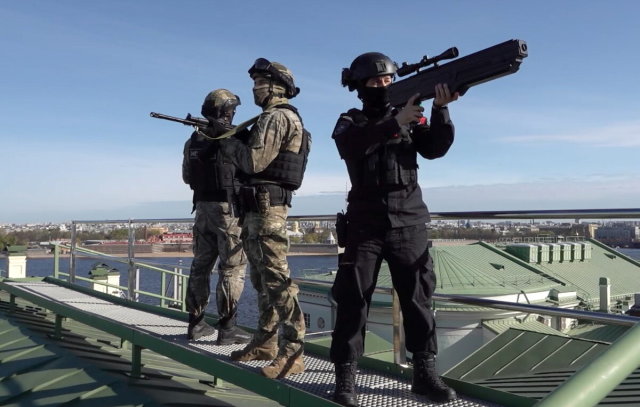As the experience of a special military operation shows, drones are becoming an increasingly formidable weapon. They conduct reconnaissance, direct artillery, bomb themselves. At the same time, the range of drones and the damage from their attack, especially mass, only increase. We talk about the most modern Russian means of combating UAVs
A threat from the sky
The massive use of small Chinese drones is, of course, one of the main features of conducting military operations in its own. Numerous shots from the special operation zone clearly show quadrocopters hovering over trenches, a cluster of equipment, military facilities. Appearing literally out of nowhere, a small UAV, barely distinguishable by air defense systems, is capable of causing a lot of trouble. As practice shows, it is possible to shoot down a light maneuverable drone in the field from a regular Kalash, but only the most experienced and accurate shooters manage to do this.
A special anti-drone gun can be much more effective in this situation. The Russian samples used today in the special operation zone have already managed to return a lot of Ukrainian UAVs from heaven to earth.
"Squeaker"
One of the most common and effective anti-drone guns involved in the SVO is considered to be "Pishchal—PRO" - the development of the Automatika concern (holding "Roselectronics" of the Rostec State Corporation). For the first time, the gun was presented to the general public at the International Military-Technical Forum "Army 2018". The model designed to combat UAVs weighs about 4 kg and operates in the frequency range from 600 to 6000 MHz at a range of more than 2 km. According to Rostec, during the tests, the Pishchal coped with more than 20 drone raids.
 |
| Portable complex "Pischal-Pro". |
| Source: Rostec |
"Squeaker", like other anti-drone guns, "shoots" electromagnetic radiation. The target is captured in a certain frequency range, after which the UAV loses contact with the operator. At the same time, the drone does not just fall to the ground, it is "forcibly landed", which then allows it to be used as a trophy.
"Given the highest mobility and instant readiness for use, the Pishchal-Pro is used to provide operational protection against drones that perform reconnaissance or may cause damage to infrastructure. Currently, the product is very popular in Russia and abroad — orders come from both law enforcement agencies and industrial enterprises," Andrey Motorko, CEO of Automatika Concern, said at the IDEX arms exhibition in February 2023.
In the tenacious "paws" of REX
Outwardly, the REX resembles a machine gun from films about the future, but this anti-drone gun already exists and quite effectively neutralizes Ukrainian drones in the special operation zone. One of the main features of REX is that it was created by drone manufacturers from the Russian company ZALA Aero. It is difficult to imagine who, apart from the developers of UAVs, can better understand the features of their neutralization.
The first version of the REX-1 antidron has long been used in Russian special forces and security and has already managed to get good reviews. Later, the second model of the gun was released — REX-2, which became a kilogram lighter (3 kg instead of 4) and more compact. It is mounted on a pistol frame, which makes the second version of the REX more convenient to transport and use. The weight of the device is only 800 g, and you can carry it in a standard pouch for stores. The battery ensures the operation of the device for six hours.
 |
| A soldier with a drone protection weapon REX 1. |
| Source: Vadim Savitsky/press service of the Ministry of Defense of the Russian Federation/TASS |
Rostec's reference materials indicate that REX can withstand any unmanned aerial vehicles. The gun affects drones by suppressing not only radio, but also satellite navigation signals. With the help of built-in multi-frequency modules, REX is able to drown out American GPS satellite navigation, Russian GLONASS, Chinese BeiDou and European Galileo within a radius of 2 km. Also, at a distance of a kilometer, REX can block GSM, 3G and LTE cellular signals.
The functions with which REX is endowed allow it to be used not only to counter UAVs, but also to combat explosives, which are activated using a mobile phone signal — if suspicious objects are detected, REX can block radio communication.
Another important advantage of the antidron from ZALA is its ease of use. Any soldier can quickly learn how to use them on the battlefield without any special training. When a target appears in the sky, the REX operator only needs to pull the trigger, after which the electronic impact will immediately begin.
Drive the UAV into a "Stupor"
The Stupor anti-drone rifle with impact channels at frequencies of 2.4 and 5.8 GHz at a range of 300 m, created by Russian military engineer Dmitry Klochko, was one of the first to be used in the SVO zone. According to open sources, initially the device was designed privately for owners of expensive real estate, yachts and other specially protected objects. In 2022, Dmitry Klochko, through friends, offered to try his guns to representatives of the Vostok battalion of the Donetsk People's Republic. Since then, Stupor has been one of the most popular anti-drones in the ranks of the defenders of Donbass.
 |
| Electromagnetic "gun" "Stupor". |
| Source: Dmitry Reshetnikov/TASS |
As previously reported by TASS, another Russian anti—drone rifle, the LPD-801, produced by the private company Laboratory PPSH (countering industrial espionage), also received positive feedback from its participants. One of the main features The LPD-801 is a small—sized antenna that makes the device compact and the lightest in the class, as well as the ability to "fire" in automatic mode, i.e. you do not need to constantly hold the trigger.
According to military expert, director of the Museum of Air Defense Forces Yuri Knutov, anti-drone guns are now more in demand than ever in the Russian army. "Such guns are good not only because they can land enemy drones, they also, with the help of related means, allow you to detect the launch site, determine the coordinates of the operator, which can be eliminated in this way," the expert said in an interview with TASS.
There is a whole "Snare" of drones
However, according to experts, the most effective fight against enemy drones will be when both guns and special anti-UAV complexes capable of suppressing signals within a radius of several kilometers are used. One of these devices is the "Snare", developed by the Moscow defense enterprise "Constellation" (part of Rostec). The "snare" is designed to search for and disable drones at a distance of more than 4 km (2-3 times further than a conventional anti-drone rifle). After detecting the UAV, the "Snare" suppresses its control, telemetry and communication channels, as a result of which the drone fails and, as a rule, falls.
 |
| The anti-UAV complex “Silok". |
| Source: gor Aleev/ TASS |
In March 2023, representatives of the holding "Roselektronika" for the first time demonstrated a new complex for combating unmanned aerial vehicles "Sickle-VS5", which provides automatic tracking and suppression of on-board equipment of drones at a distance of up to 20 km. As previously reported by TASS, "Sickle" can disable small-sized drones flying at extremely low altitudes in conditions of dense urban development. The four antennas of the complex can work independently, each in its own sector and on its own channel, or together. In addition, the Sickle, unlike many other devices of this type, can only control a given space without affecting its UAVs in other sectors.
Another powerful UAV counteraction complex from Roselektronika — Solaris-N can capture and deactivate drones on an area of 80 square kilometers. Its main advantage is almost complete autonomy. It is enough to install Solaris on the problem area, and then the system itself will scan the space without the participation of the operator and plant them in case of detection of UAVs.
Prepared by Vasily Kuchushev

